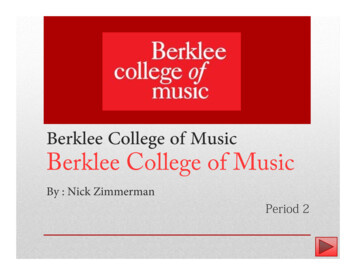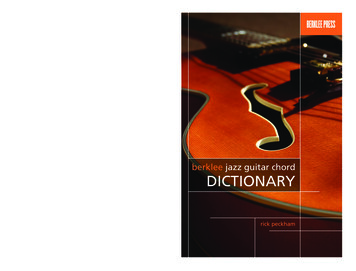
Transcription
The Pentatonic ScalePentatonic scales have only five notes (“penta” means “five”). There are two common pentatonicscales: the major pentatonic and the minor pentatonic.Major Pentatonic ScaleThe major pentatonic scale shares five notes with the major scale. The first, second, third, fifth, andsixth notes of the major scale become the five notes in the major pentatonic scale.Minor Pentatonic ScaleRemember the relative minor scale? The relative minor scale uses the same notes as the major scalebut starts on the sixth degree of the major scale.
The minor pentatonic scale uses the same notes as the major pentatonic scale, but starts on the sixthdegree of the major pentatonic scale.Exercise #1Draw a line to match the major pentatonic to its relative minor pentatonic.(Answers on page 7)
Exercise #2Label the scale degrees of the major pentatonic scales. Then notate its relative minor scale and itsscale degrees.(Answers on page 7)A Closer Look at the Major and Minor Pentatonic ScalesIn the traditional Ionian (major) and Aeolian (natural minor) scales, there exists a tritone (augmentedththththnd4 /diminished 5 ) between the 4 and 7 scale degrees in Ionian and the 2 and b6 scaledegrees in Aeolian.Major and minor pentatonic scales avoid significant harmonic dissonance by adverting this tritone.
Intervallic Patterns in a Pentatonic ScaleScales have a set intervallic pattern (or in most cases “steps”), which begin on the scale’s root. Forexample, the Ionian (major) scale has a stepwise pattern of WWHWWWH (“W” means whole stepand “H” means half step. The major pentatonic scale has an intervallic pattern of a M2, M2, m3, M2,and a final m3 (“M” represents major and “m” represents minor), which leads to the octave of theroot.The minor pentatonic scale has its own intervallic pattern of a m3, M2, M2, m3, and a final M2, whichleads to the octave.The image below shows us how these major and minor pentatonic intervallic patterns relate to oneanother.
Exercise #3Using the pentatonic intervallic patterns, build the pentatonic scales indicated below.(Answers on page 7)Building a Pentatonic Scale Using FifthsThe major and minor pentatonic scale can also be built using four consecutive intervals of a perfectfifth (P5).
Arranging these notes into a single octave with our first note of C as the root, we can create themajor pentatonic scale, C, D, E, G, and A with scale degrees of 1, 2, 3, 5, and 6 (8 representing theroot’s octave) as seen below:C’s relative minor pentatonic scale, A minor pentatonic, begins on the 6th scale degree of the majorpentatonic scale (shown above).A minor pentatonic contains scale degrees 1, b3, 4, 5, and b7.Using the circle of fifths as a tool we can see how this works in a sharp direction. The image belowrepresents four consecutive perfect fifths in the circle of fifths starting on the root of C andcontinuing in a sharp direction:
Answer Key
Arranging these notes into a single octave with our first note of C as the root, we can create the major pentatonic scale, C,










